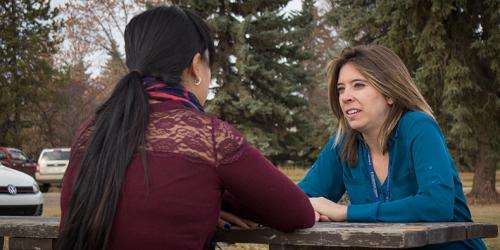Students show value of occupational therapy in addiction treatment

When Lauren Barrett arrived at the Henwood Treatment Centre for a six-week clinical placement this past year, occupational therapy was barely on the radar.
Administrators and staff at the Edmonton-area addiction treatment centre had little experience working with occupational therapists, so even knowing what skill sets they brought to the table required an education process.
But by the time Barrett and fellow student Chantal Moen finished their placements, they had opened enough eyes about their profession that a staff occupational therapist position was created—a first for Henwood. Barrett was hired and started in that role in early September.
"It was the opportunity of a career," Barrett said of her independent community placement (ICP) through the University of Alberta's Department of Occupational Therapy. "This is exactly what I would like to do. I always knew mental health was always where I'd probably end up, but addiction and mental health are a great fit for me."
Occupational therapy students must complete four clinical placements during their two-year master's program, working with mentor occupational therapists in health-care settings around the province and Canada. Independent community placements are slightly different in that they're optional and students have a chance to experience environments where there is no practising occupational therapist.
Students work in pairs and receive guidance from the ICP office, but their direct supervisor is on site, usually someone with a completely different educational background and skill set, explained Loraine Kolber, who as ICP fieldwork educator works with agencies to set up placement opportunities. For Henwood, which is operated by Alberta Health Services, that meant engaging the centre's administration about what occupational therapy is and gathering input on how students could fit within the organization, she said.
For Barrett, the placement meant working alongside Moen, a fellow classmate and friend. Together, they brainstormed a lot of ways to introduce occupational therapy to Henwood to maximize the benefit for clients who go through the facility's 19-day treatment program.
Initially, that meant educating other health professionals and staff—social workers, addiction counsellors, nurses, recreational therapists and others—about the role an occupational therapist can play in addiction treatment, from insomnia and sleep management to chronic pain management.
The students also visited the homes of clients to identify potential addiction triggers, such as drug paraphernalia, and offered support while removing and cleaning up the material—another first for the centre, said Glenn Walmsley, Henwood's manager of care.
"One of our clients didn't even know if she could go into her home and clean it up without craving and wanting to use. What Lauren and Chantal were able to do, the skills they brought, goes beyond mobility needs and straight into the addictions environment," he said.
The students' work made such an impact with Henwood's staff, Walmsley knew he had to find a way to create a staff position.
"When the six weeks were up, I had numerous staff come to me and say, essentially, 'You have to get an OT here.' That was in just six weeks. I've never had that kind of reaction. It's so obvious how they play a role here."
Barrett said that's because occupational therapy "speaks the same language" as Henwood, blending smoothly with its program and other clinical services. Occupational therapy makes Henwood better, she said, and she in turn is inspired and challenged by the environment.
"The clients I work with are fantastic, some of the best people in the world," Barrett said. "When you see them on their first day, in their first week, they're scared and anxious and in a really tough place. As you get to know them and see them as they go through their three-week program—it's only three weeks, which if you think about it in the grand scheme of life is a drop in the bucket. But that drop was pretty murky when you first saw it and by the end it's starting to clear. When you can see that in a person, that's a reward."

















